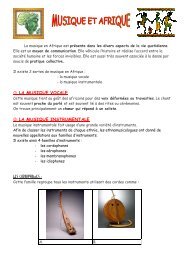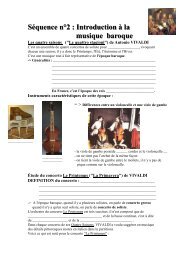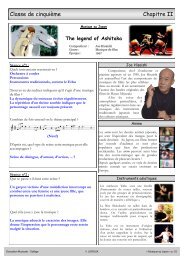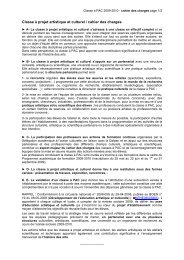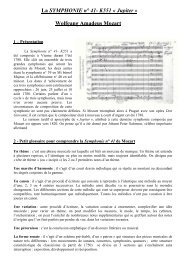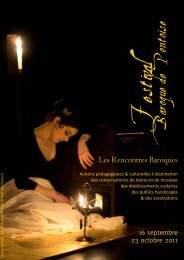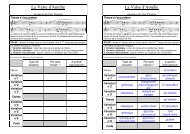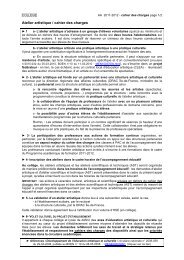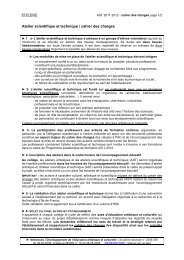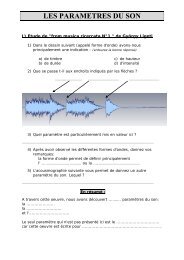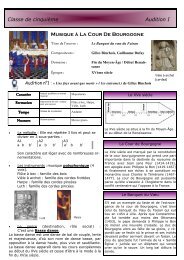Conférence sur la Fanfare for the common man
Conférence sur la Fanfare for the common man
Conférence sur la Fanfare for the common man
You also want an ePaper? Increase the reach of your titles
YUMPU automatically turns print PDFs into web optimized ePapers that Google loves.
obvious reasons, only conditioned “duty calls”, <strong>common</strong>ly called “points of war”, such as “Mount”, and<br />
“routine calls” of <strong>the</strong> kind of <strong>the</strong> “Reveille”. Indeed, as <strong>la</strong>te as <strong>the</strong> 18 th century a “flourish” of <strong>the</strong> British<br />
Army was “without any set rule”. Later a fixed notation emerged <strong>for</strong> those “flourishes” in <strong>the</strong> British<br />
Army which were intended <strong>for</strong> royalty and general officers. That <strong>for</strong> <strong>the</strong> first-named “salute” was<br />
derived from <strong>the</strong> old cavalry “Parade March”, firs printed in 1798, although it was older. It is still in use<br />
when a regimental band is not present <strong>for</strong> <strong>the</strong> corresponding salute.<br />
The familiar example of a fanfare, often p<strong>la</strong>yed on occasions of state by <strong>the</strong> trumpeters of <strong>the</strong><br />
Household Cavalry, is <strong>the</strong> following, which is always p<strong>la</strong>yed in unison:<br />
The <strong>la</strong>test official version of this, which is used in <strong>the</strong> army <strong>for</strong> <strong>the</strong> “General Parade” call, is men<strong>sur</strong>ally<br />
different. It is said to date from <strong>the</strong> time of Charles II, but in 1798 this was <strong>the</strong> call “To Horse”.<br />
Not all military fanfares were in unison. Hyde (1798) gives a stirring flourish <strong>for</strong> <strong>the</strong> per<strong>for</strong><strong>man</strong>ce of<br />
“Return Swords”, which is just of sufficient length to enable <strong>the</strong> sabres’points to find <strong>the</strong> scabbards’<br />
mouths, with tye resounding rattling home of <strong>the</strong> hilt <strong>for</strong> <strong>the</strong> final crescendo pause. Here it is:<br />
(2) Non-military fanfares are usually connected with state or o<strong>the</strong>r ceremonies and also frequently occur<br />
on <strong>the</strong> stage in scenes reproducing such ceremonies: e.g. Shakespeare’s “tuckets” and “sonnets”.<br />
In recent years it has become <strong>the</strong> custom <strong>for</strong> <strong>the</strong> ceremonial fanfares to be written by distinguished<br />
composers, such as those by Ernest Bullock <strong>for</strong> <strong>the</strong> coronation of King George VI and by Bax <strong>for</strong> Princess<br />
Elizabeth’s wedding.<br />
So picturesque and effective a feature as <strong>the</strong> fanfare has not been neglected by opera composers. No<br />
one who has heard it can <strong>for</strong>get <strong>the</strong> effect of <strong>the</strong> two flourishes announcing <strong>the</strong> arrival of <strong>the</strong> Governor<br />
in ‘Fidelio’, both in <strong>the</strong> opera and in <strong>the</strong> ‘Leonore’ overtures Nos. 2 and 3. True to <strong>the</strong> fact, Beethoven<br />
has written <strong>the</strong>m in unison (in <strong>the</strong> final version of <strong>the</strong> opera and <strong>the</strong> <strong>la</strong>ter overture in Bb, in <strong>the</strong> earlier<br />
overture in Eb, with triplets). O<strong>the</strong>r composers, not so conscientious, have given <strong>the</strong>m in harmony,<br />
sometimes with <strong>the</strong> addition of horns and trombones, <strong>for</strong> instance in Spontini’s ‘Olympie’, Meyerbeer’s<br />
‘Struensee’, Act II, Amboise Thomas’s ‘Hamlet’ and <strong>man</strong>y more. A good example is <strong>the</strong> fanfare in<br />
Wagner’s ‘Tannhaüser’, which <strong>for</strong>ms <strong>the</strong> basis of <strong>the</strong> march. It is <strong>for</strong> three trumpets in Bb. <strong>Fanfare</strong>s<br />
which, instead of being merely decoration, take a share in <strong>the</strong> dramatic effect of an operatic scene,<br />
occur, <strong>for</strong> example, in Bizet’s ‘Carmen’ (Acts I and II) and Verdi’s ‘Otello’ (Act III). Effective use has also<br />
been made of fanfares in modern incidental music to p<strong>la</strong>ys and in music <strong>for</strong> films, as by William Walton<br />
in his stage music <strong>for</strong> ‘Macbeth’ and his film score <strong>for</strong> ‘Henry V’.<br />
(3) French cavalry bands, and indeed brass band in general in France, are termed <strong>Fanfare</strong>s.<br />
(4) The word is also employed in a general sense <strong>for</strong> any short prominent passage of <strong>the</strong> brass, such as<br />
that of <strong>the</strong> trumpets and trombones (with <strong>the</strong> woodwind also) near <strong>the</strong> end of <strong>the</strong> fourth movement in<br />
Schu<strong>man</strong>n’s Eb Symphony, or of <strong>the</strong> whole wind band in <strong>the</strong> opening Andante of Mendelssohn’s<br />
Re<strong>for</strong>mation Symphony.<br />
(5) In 1921 a monthly paper called ‘The <strong>Fanfare</strong>’ was started in London under <strong>the</strong> editorship of Philip<br />
Heseltine and Cecil Gray to voice contemporary views of music. A number of prominent composers were<br />
invited to write fanfares <strong>for</strong> publication in <strong>the</strong> first number. Several of <strong>the</strong>ir productions were per<strong>for</strong>med<br />
at Eugene Gossens’s concerts of contemporary music in Queen’s Hall (Oct. 1921). The paper soon died.<br />
A <strong>la</strong> lecture de ces différentes définitions, le terme de <strong>Fanfare</strong> recouvre donc plusieurs sens.<br />
Le premier d’entre eux puise son origine dans les instruments de <strong>la</strong> famille des cuivres eux-mêmes.<br />
En effet, on identifie des œuvres jouées par ces instruments sous le nom générique de "fanfare",<br />
14



